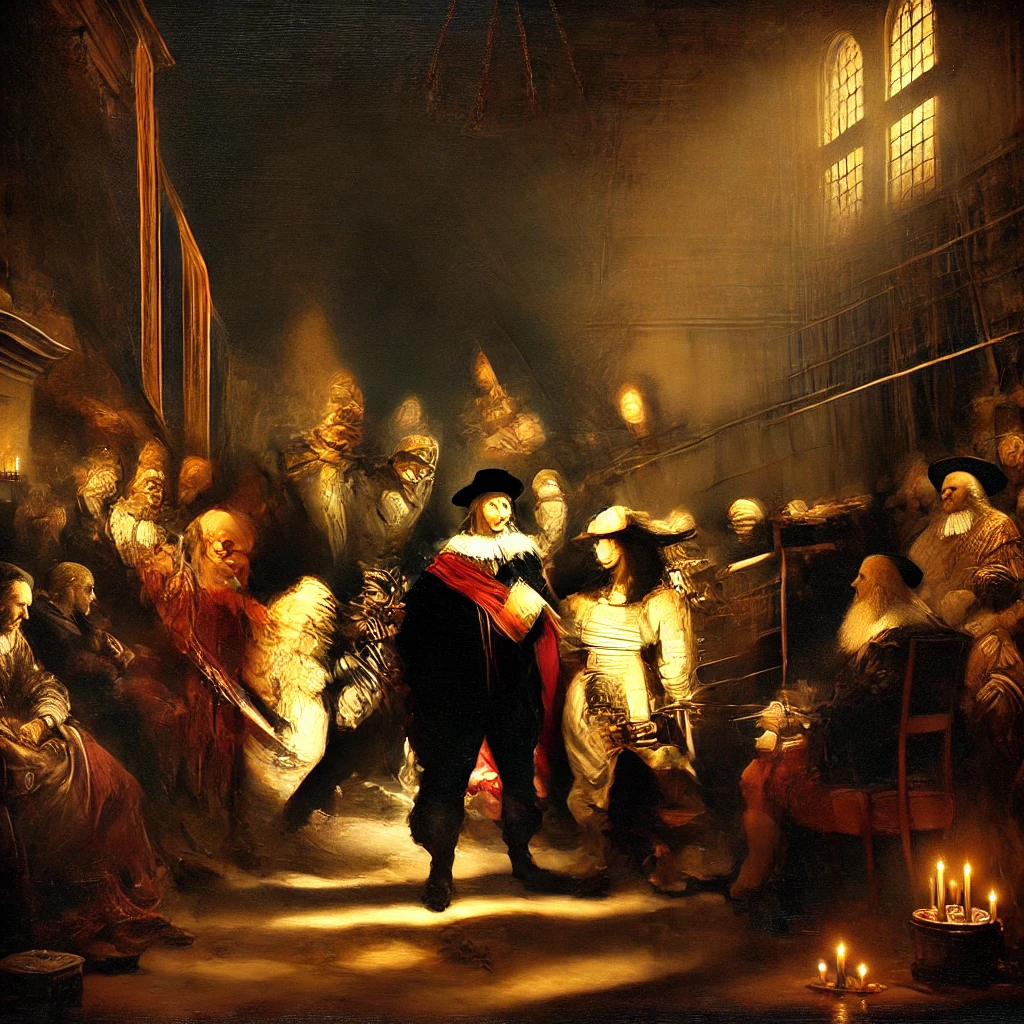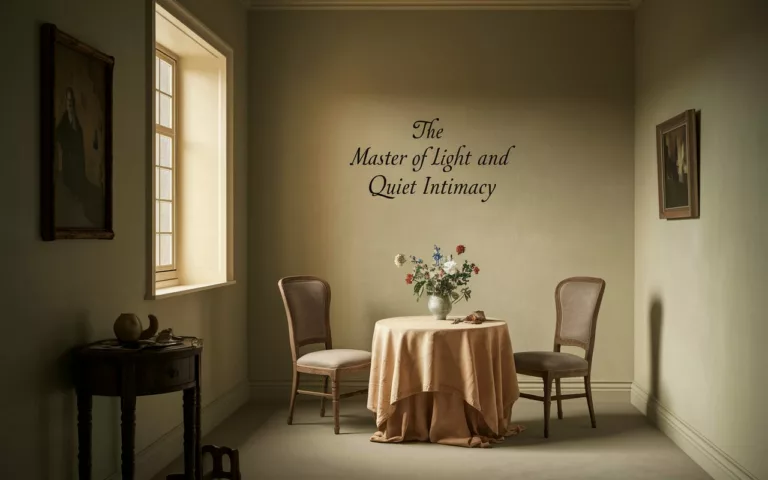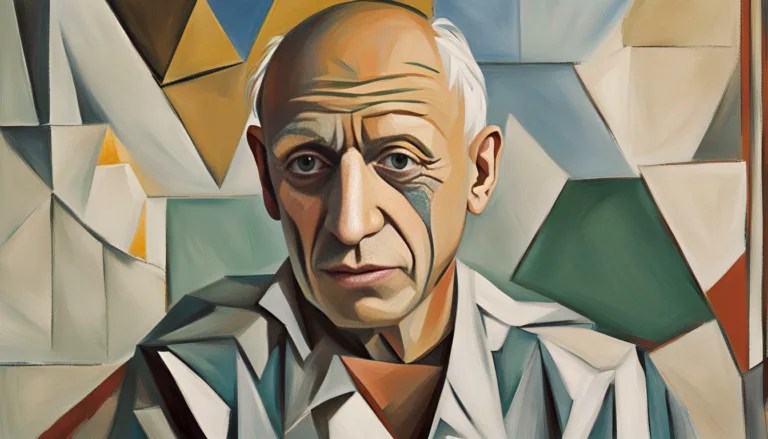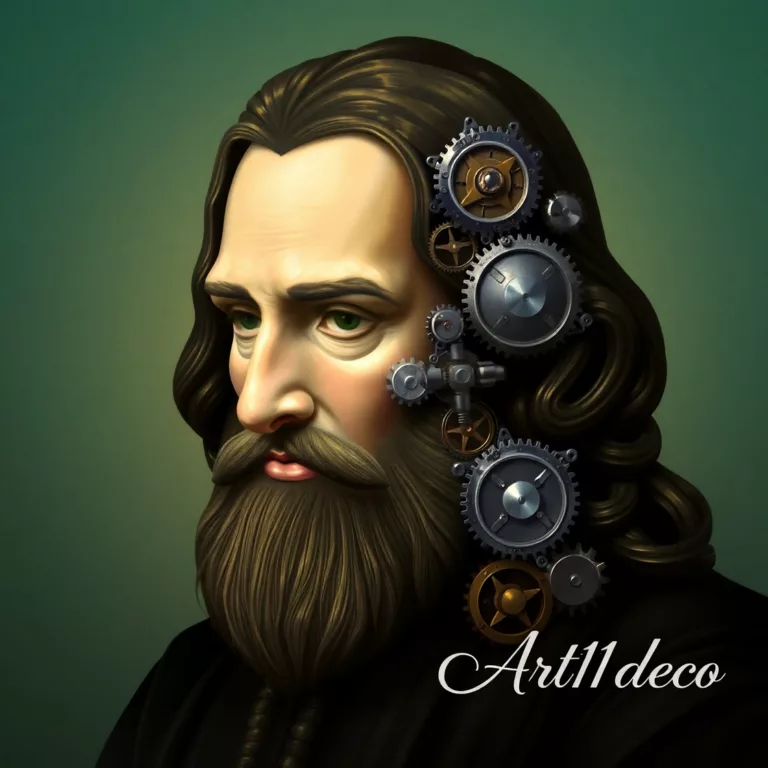Rembrandt: Master of Light and Shadow in Dutch Art
In the grand narrative of Western art, few names command the reverence afforded to Rembrandt Harmenszoon van Rijn. Simply known as Rembrandt, this 17th-century Dutch master transcended the boundaries of his time to create works of such psychological depth and technical brilliance that they continue to move viewers nearly four centuries after their creation. While his contemporaries may have achieved fame through flattering portraits of the wealthy or idealized religious scenes, Rembrandt pursued a more profound truth—one that explored the full spectrum of human experience through his revolutionary use of light, shadow, and unflinching honesty.
The Making of a Master: Early Life and Education
Born on July 15, 1606, in Leiden, Netherlands, Rembrandt emerged from relatively humble beginnings. The son of a miller and a baker’s daughter, he showed artistic promise at an early age. His parents, recognizing his talent, arranged for him to receive a proper education—first at the Latin School in Leiden and later, in 1620, at the University of Leiden. However, the young Rembrandt’s passion for art soon eclipsed his academic studies, leading him to abandon university to pursue apprenticeships with local painters.
His first significant artistic training came under Jacob van Swanenburg, with whom he studied for three years. This foundational period was followed by a brief but influential six-month apprenticeship with the renowned history painter Pieter Lastman in Amsterdam. From Lastman, Rembrandt absorbed crucial lessons in composition and narrative technique that would inform his approach to historical and biblical subjects throughout his career.
By 1625, still barely into his twenties, Rembrandt had established his own studio in Leiden, taking on students despite his youth. His early works already displayed the technical proficiency and dramatic lighting effects that would become his hallmark, attracting attention from collectors and fellow artists alike. This precocious talent marked him as exceptional even in an era noted for its artistic richness.
Rise to Prominence: The Amsterdam Years
In 1631, recognizing the greater opportunities offered by the Netherlands’ largest city, Rembrandt relocated to Amsterdam—then emerging as one of Europe’s most prosperous commercial centers. The timing proved fortuitous; the Dutch Golden Age was in full swing, with the newly independent Dutch Republic establishing itself as a global trading power. This commercial success created a wealthy merchant class eager to demonstrate their prosperity and taste through art patronage.
Rembrandt quickly secured the patronage of prominent art dealer Hendrick van Uylenburgh, whose cousin Saskia he would marry in 1634. Through van Uylenburgh’s connections, Rembrandt received numerous portrait commissions from Amsterdam’s elite. His marriage to Saskia, herself from a wealthy family, further cemented his social position and provided financial stability.
The 1630s marked Rembrandt’s commercial peak. His portraits were in high demand, commanding substantial fees. His studio expanded, attracting numerous students eager to learn from the increasingly famous master. In 1639, confident in his success, Rembrandt purchased an expensive house on Sint Anthonisbreestraat (now Jodenbreestraat)—a mansion beyond the means of most artists of the era, requiring him to take out a significant mortgage that would later contribute to his financial troubles.
Revolution in Portraiture: Seeing Beyond the Surface
What distinguished Rembrandt from his contemporaries in portraiture was not merely technical brilliance but his revolutionary approach to depicting human subjects. While many portraitists of the Dutch Golden Age produced flattering, idealized images of their wealthy patrons—emphasizing fine clothing, jewelry, and dignified poses—Rembrandt sought to capture something more elusive: the inner life of his subjects.
His portraits reveal character through subtle facial expressions, thoughtful gazes, and the interplay of light and shadow. Even in commissioned works, where clients expected favorable representation, Rembrandt insisted on psychological truth. His subjects appear as fully realized individuals with complex inner lives, rather than merely as displays of wealth and status.
This commitment to psychological realism reached its apex in his self-portraits—an unprecedented series of approximately 80 paintings, etchings, and drawings spanning his entire career. From the confident young artist with tousled hair to the weathered elder examining his aged face with unflinching honesty, these works constitute perhaps the most thorough visual autobiography in art history before the modern era.
The self-portraits serve multiple functions: as technical exercises, as advertisements of his skill to potential clients, and as profound meditations on mortality and the human condition. They document not only the physical changes of aging but also the spiritual and emotional evolution of an artist confronting success, failure, loss, and his own mortality with extraordinary candor.
The Alchemy of Light: Technical Innovations
Rembrandt’s most recognizable technical achievement—his mastery of chiaroscuro (the dramatic use of light and shadow)—represents far more than a stylistic choice. It became a metaphysical statement, a visual language for exploring the mysterious aspects of human experience. His mature works often feature figures emerging from deep darkness, illuminated by a seemingly divine light source that reveals essential truths while leaving peripheral elements in obscurity.
This technique, sometimes called “Rembrandt lighting” by modern photographers, typically involves illuminating one side of the subject’s face while the other side recedes into shadow, often with a small triangle of light on the shadowed cheek. The effect creates dimensional depth while emphasizing the emotional and spiritual aspects of the subject.
Equally revolutionary was his approach to paint application. Rembrandt developed a unique method of building up thick layers of paint (impasto) in lighter areas while keeping shadowed areas thin and transparent. This technique created an almost sculptural quality in his work, with the paint itself becoming a three-dimensional element. In highlights—a metal goblet, a gold chain, or the gleam in a subject’s eye—the paint might stand several millimeters from the canvas, catching actual light in the physical world to enhance the illusion of illumination within the painted scene.
Contemporary observers noted how his paintings changed dramatically when viewed from different distances—appearing almost chaotic when examined closely but resolving into perfect clarity when seen from a proper viewing distance. This technique, seemingly careless but actually precisely calculated, was entirely revolutionary in Western art.
Biblical Narratives: Humanizing the Divine
While portraiture brought Rembrandt commercial success, his personal passion increasingly lay in depicting biblical narratives. Unlike many religious painters who emphasized the divine or miraculous aspects of these stories, Rembrandt focused on their human dimensions—the moral complexities, emotional struggles, and psychological depth of biblical characters.
His approach to religious subjects was distinctly Protestant in its emphasis on the direct, personal relationship between humans and the divine, without the intercession of saints or elaborate religious hierarchies that characterized Catholic religious art. Yet his work transcended sectarian divisions, finding universal human truths in these ancient stories.
“The Return of the Prodigal Son,” perhaps his most beloved religious painting, exemplifies this approach. Completed near the end of his life, this masterpiece depicts the moment of reconciliation between a wayward son and his forgiving father. Rather than emphasizing the moral lesson or religious doctrine, Rembrandt focuses on the profound human emotion of the scene—the father’s compassionate embrace, the son’s humble submission, the complex reactions of onlookers. The painting becomes not just an illustration of a biblical parable but a profound meditation on forgiveness, grace, and the complex nature of human relationships.
Similarly, in “The Sacrifice of Isaac,” Rembrandt captures the psychological horror of Abraham’s near-sacrifice of his son, depicting the precise moment when the angel intervenes—Abraham’s face showing both religious devotion and paternal anguish. These religious works, while deeply respectful of their source material, refuse simplistic or dogmatic interpretations, instead exploring the ambiguities and emotional complexities of faith.
The Night Watch: Triumph and Controversy
No discussion of Rembrandt’s achievement would be complete without examining “The Night Watch” (1642)—officially titled “The Company of Captain Frans Banning Cocq and Lieutenant Willem van Ruytenburch,” but known by its more evocative nickname for centuries. This massive group portrait, commissioned by Captain Cocq and seventeen members of his civic guard, represents both Rembrandt’s technical pinnacle and a turning point in his career.
Breaking radically from the conventional group portrait format—in which each paying subject would be given equal prominence and depicted in static, dignified poses—Rembrandt created a dynamic composition showing the guard in action, preparing to march out. He arranged the figures in a complex, multi-layered composition with dramatic lighting that emphasized some members while relegating others to shadow or partial visibility.
The painting’s revolutionary nature extends beyond its composition. Rembrandt’s contemporaries typically painted militia companies in formal, static arrangements that emphasized the members’ social status. By contrast, “The Night Watch” captures a moment of movement and action, transforming a standard group portrait into a dramatic narrative scene. Captain Cocq and Lieutenant van Ruytenburch stand in the center, bathed in golden light, while around them swirls a complex arrangement of guardsmen in various states of preparation.
Popular mythology suggests that this unconventional approach displeased some of the subjects who had paid equal shares but received unequal prominence, contributing to Rembrandt’s subsequent decline in popularity. However, modern scholarship questions this narrative, noting that the painting remained in its prominent public location and that Cocq himself seems to have been satisfied with the result.
What is certain is that “The Night Watch” marked a stylistic breaking point. After its completion, Rembrandt’s commissions from Amsterdam’s elite began to decline, whether due to changing artistic tastes, his increasingly unconventional approach, or personal factors. Whatever the cause, this masterpiece stands as the culmination of his early success before the more troubled period that would follow.
Personal Tragedies and Financial Decline
As Rembrandt’s artistic vision deepened, his personal life was marked by a series of devastating losses. His beloved wife Saskia died in 1642 (the same year he completed “The Night Watch”), likely from tuberculosis, shortly after the birth of their son Titus—the only one of their four children to survive infancy. Her death marked the beginning of a period of personal and financial turmoil.
Rembrandt’s household arrangements following Saskia’s death became complicated and somewhat scandalous by the standards of the time. He hired a widow named Geertje Dircx as a nurse for young Titus, and they apparently became lovers. The relationship ended acrimoniously, with Geertje suing Rembrandt for breach of promise of marriage. Shortly thereafter, Rembrandt became involved with his much younger household servant, Hendrickje Stoffels, who would remain his devoted companion until her death in 1663.
These domestic arrangements coincided with mounting financial problems. Despite his earlier commercial success, Rembrandt had lived beyond his means, collecting art and rare objects while failing to pay off the mortgage on his expensive home. His artistic choices may have contributed to his financial decline; as Amsterdam’s elite gravitated toward a more refined, elegant style influenced by Flemish and French models, Rembrandt moved in the opposite direction, developing an increasingly rough, expressive technique that emphasized emotional truth over superficial beauty.
In 1656, unable to meet his financial obligations, Rembrandt was forced to declare bankruptcy. His house and possessions—including his substantial art collection—were auctioned to pay his debts. He moved with Hendrickje and Titus to more modest accommodations in the Jordaan district, where he would spend his remaining years.
Late Masterpieces: Wisdom in Adversity
If Rembrandt’s middle years were marked by commercial decline and personal tragedy, they also witnessed the creation of some of his most profound work. Freed from the necessity of pleasing wealthy patrons, he pursued his artistic vision with even greater independence, developing a style of extraordinary emotional depth and technical freedom.
His late self-portraits stand among the most moving depictions of aging in Western art. Works like “Self-Portrait with Two Circles” (c. 1665-1669) show the artist in old age, his face deeply lined, his expression contemplative but not defeated. These paintings combine technical brilliance with unflinching self-examination, documenting not just physical decline but accumulated wisdom and resilience.
The Jewish Bride” (c. 1665-1669)—a tender depiction of a couple, possibly Isaac and Rebecca from the Old Testament—reveals Rembrandt’s late mastery of paint handling. The thick impasto of the man’s sleeve and the woman’s dress creates an almost tactile quality, while the gentle placement of his hand on her breast conveys intimate affection with extraordinary subtlety. The painting’s emotional power moved Vincent van Gogh to declare that he would give “ten years of his life” to sit before this canvas for a fortnight with only a crust of dry bread to eat.
In these late works, Rembrandt achieved a perfect synthesis of technical virtuosity and emotional depth. The loose, almost rough brushwork, which might appear careless to a casual observer, actually represents the culmination of a lifetime of technical experimentation—a visual language capable of expressing the deepest human emotions with unprecedented directness.
Legacy and Influence: The Master’s Enduring Light
Rembrandt died on October 4, 1669, leaving behind a modest estate and an immeasurable artistic legacy. He was buried in an unmarked grave in the Westerkerk, a fate that seems incongruous with his stature but reflects his financial circumstances at the time of his death.
While his reputation experienced fluctuations over the centuries—sometimes criticized for his rough technique or dark tonalities when smoother, more decorative styles were in favor—Rembrandt’s stature has ultimately transcended changing tastes. By the 19th century, with the rise of Romanticism and its emphasis on emotional expression, his work was recognized as transcending the boundaries of the Dutch Golden Age to speak to universal human experiences.
His influence extends far beyond those who explicitly emulated his style. The psychological depth of his portraits presaged the modern interest in the inner life of subjects. His expressive brushwork, particularly in his late works, anticipated aspects of Impressionism and Expressionism centuries later. His mastery of light and shadow influenced not only painters but also photographers and cinematographers, who still refer to “Rembrandt lighting” as a specific technique.
Perhaps most significantly, Rembrandt expanded the emotional range and psychological depth possible in visual art. He demonstrated that painting could explore the full spectrum of human experience—from the exalted to the humble, from joy to profound grief—with unflinching honesty and deep compassion.
The Universal in the Particular: Why Rembrandt Still Matters
What makes Rembrandt’s work continue to resonate nearly four centuries after his death? Beyond his technical brilliance—his mastery of light and shadow, his revolutionary paint handling—lies his profound empathy for the human condition.
Whether depicting biblical patriarchs, Amsterdam merchants, or himself in old age, Rembrandt captured something essential about human experience. His subjects are never mere types or symbols but fully realized individuals with complex interior lives. Even in his religious works, the focus remains on the human dimension of spiritual stories—the doubt, fear, love, and faith that make biblical narratives relevant across centuries and cultures.
This deep humanism explains why viewers from radically different times and places can stand before a Rembrandt portrait and feel an immediate connection across the centuries. His vision was simultaneously specific to his time and place—the bustling commercial center of 17th-century Amsterdam—and universal in its emotional resonance.
In an age of increasingly virtual experiences and digital reproductions, Rembrandt’s physical paintings offer something that cannot be fully captured in any reproduction: a tangible connection to a human hand that moved across these canvases centuries ago, building up layers of paint to capture fleeting emotions and eternal truths. The actual brushstrokes, visible and almost sculptural in their thickness, connect us physically to the moment of creation in a way that transcends time.
As we stand before his work today, we participate in a conversation that spans centuries—between an artist who refused to settle for superficial beauty or conventional success, instead pursuing a deeper truth about what it means to be human, and viewers who continue to find in his vision a reflection of their own humanity. In the play of light and shadow that was his signature, Rembrandt continues to illuminate the depths of human experience for each new generation of viewers, his artistic legacy as enduring as the questions about mortality, love, faith, and meaning that he explored with such unflinching honesty and profound compassion.
Art11deco







